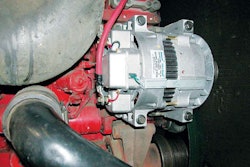Raising truck weight limits on U.S. highways has been put off for the time being.
A bipartisan amendment to require a study of the impact of heavier truck weight limits was approved today, Feb. 2, as debate opened on the $260 billion American Energy and Infrastructure Jobs Act (H.R. 7). The amendment by Reps. Lou Barletta (R-Pa.) and Jerry Costello (D-Ill.) passed on a 33-20 vote.
The defeated provision would have permitted trucks pulling single trailers to weigh up to 97,000 pounds on six months, an increase from the current limit of 80,000 pounds on five axles.
The American Trucking Associations and the Coalition for Transportation Productivity on Jan. 31 both backed the surface transportation legislation, a reauthorization bill the groups say also will streamline the Department of Transportation and modify federal transportation programs.
ATA said the surface transportation bill not only will make needed improvements to the nation’s highway system, but also will make that system safer for trucks and cars. “This bill is a major step forward, not just for trucking but for all users of our transportation system,” said Bill Graves, ATA president and chief executive officer.
Graves said ATA also is pleased the bill includes a number of safety provisions, ranging from the creation of a drug and alcohol testing clearinghouse to stricter driver training requirements, and takes steps toward establishing crashworthiness standards for large trucks that ATA has championed. ATA also praised the legislation for addressing truck productivity and hours-of-service.

“We’re pleased that for the first time in 30 years, despite unfounded yet curiously well-funded attacks on the safety of our industry, the House appears set to make much-needed reforms to federal truck size and weight limits,” said Dan England, ATA chairman and chairman of Salt Lake City-based C.R. England Inc.
England said the bill directs the Federal Motor Carrier Safety Administration to initiate a field study of its proposed hours-of-service changes, specifically the impacts of the proposed modifications to the 34-hour restart provision. “The researchers whose work was used to justify these changes said a field study was needed to understand the safety, cost and operational implications of such a change, and we agree wholeheartedly,” he said.
CTP, a group of 200 shippers and allied associations seeking increased federal vehicle weight limit on interstate highways, supported the truck weight reform proposal’s inclusion in the bill. The legislation would reform the federal vehicle weight limit by giving states the authority to permit larger single-trailer trucks weighing up to 126,000 pounds on up to 25 miles of 
The proposal would have allowed states to opt into a higher federal interstate vehicle weight limit for single-trailer trucks equipped with six axles rather than the typical five. The required sixth axle would maintain all braking and handling characteristics at the new limit of 97,000 pounds, enabling shippers to utilize truck space that remains empty at the current 80,000-pound federal weight limit.
CTP said this proposal will reduce the truckloads, fuel and vehicle miles necessary to meet demand, and that participating states will have full authority to exclude these trucks from operating on any route or bridge.
“Truck capacity has dropped by 16 percent since the recession started, and the 30-year-old federal vehicle weight limit compounds the problem by forcing many trucks to travel when they are only partially full,” said John Runyan, CTP executive director.
Runyan said more than 90 percent of states already employ higher weight limits on state roads and bridges. Truck weight reform also would make American companies more competitive in the global marketplace, according to CTP; a recent study by the Organisation for Economic Co-Operation and Development compared truck productivity among developed nations and found that U.S. tractor semi trailers are the least productive due to highly restrictive vehicle weight limits.
The Owner-Operator Independent Drivers Association opposes increasing truck weight limits, as well as making longer combination vehicles, including double and triple trailers, the industry standard. “Truck drivers know firsthand that heavier and longer trucks are much harder to maneuver and put additional stress on our already deteriorating highways and bridges,” said Todd Spencer, OOIDA executive vice president.
AAA also opposes the higher truck weight limit. “Additional research is required to demonstrate exactly how bigger and heavier trucks would impact traffic safety. Absent this research, we cannot take the chance – there is simply too much at stake,” said AAA Managing Director of Government Relations & Traffic Safety Advocacy Jill Ingrassia.
The Senate will tackle its own version of a highways bill that doesn’t contain a provision for heavier trucks and covers two years instead of five.
The House bill will be debated and voted upon Feb. 2.











